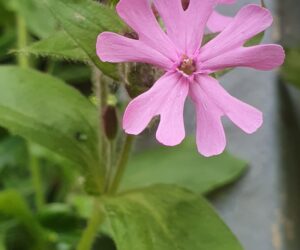Red campion is a medium to tall native wildflower. In May, right through to late summer, large swathes of pinkish-red flowers commonly adorn the banks of streams, the seashore, deciduous forest margins, hedgerows, waste land or roadside verges.
Behaviour
Red campion never grows in very dry places. Like many other pink family members that grow on extremely alkaline rock it has developed its own hairy, low, narrow-leaved and small-flowered form.
It is dioecious (male and female flowers grow on separate plants) and relies heavily on insects, such as long-tongued bumblebees and hoverflies for transfer of pollen. The main flowering season is in May and June. The flowers each have five petals approximately 1.5 to 2.5 cm across. When the plant has ceased flowering, the seed capsules appear. The capsules open at the top, allowing the numerous small, black seeds to escape.
Red campion is a perennial with creeping underground rhizomes – which allow it to spread.
Size
Height: up to 1m; more commonly 20-60 cm
Status
Common
Distribution
Red campion is a lowland wild flower abundant throughout Britain except in the Scottish Highlands, Northern Scotland, Norfolk and the Outer Hebrides.
When to see
May to September
Facts
Red campion flowers during the day. Its close relative White campion (S. latifolia) opens its flowers at night, but the species share some pollinators and therefore cross-breed with each other. The hybrid is hairy and pink-flowered.
Red campion is also known as adder’s flower, robin hood, cuckoo flower or as bachelor’s buttons and probably used to be worn in the button holes of bachelors.
The root is used as a soap substitute for washing clothes etc. The soap is obtained by simmering the root in hot water.

